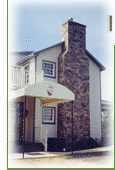History of Kellysville
Shortly after 1725 J.P. Kelly patented a tract of land 60 miles southwest of Washington, D.C. and along the Rappahannock River. By 1773 the Kelly family owned land on both sides of the river. Ever since, the locality has been known as Kelly's Ford or Kellysville. From Colonial times until the Civil War Kelly's Mill and other enterprises were a thriving center of trade in Culpeper County. The canals along the river were the main arteries of transportation for the Piedmont area of Virginia.
Kelly's Ford was no longer a Ford by December 1848 when the Rappahannock Navigation was complete on John P. Kelly's new bridge, the first to span the river. John P. Kelly's son Granville became Postmaster of Kellysville in 1849, soon to become the largest manufacturing complex in Culpeper County.
About 100 men worked Kelly's flourmill, its capacity - 100 barrels a day. Son Granville ran the cloth factory and the general store, and Kellysville also boasted a blacksmith and wheelwright shop, a copper shop, sawmill and shoe shop where shoes were made from local hides. Every December 31 and New Years Day, 100 hogs became sausage and smoked meat.

In early summer of 1862 Granville Kelly dismantled his looms and machinery to keep the approaching Federals from destroying the works. Shipped to Lynchburg, they were never to return. The hay-day of Kellysville ended with the war and in retaliation for the Kelly's Confederate sympathies, the Post Office closed July 9, 1866.
Granville Kelly rebuilt the mill complex on a smaller scale and on July 2, 1879, a Kellysville Post Office reopened. The Post Office closed on January 15, 1924 but the store lingered until the mill fell with the flood of 1936.
The Kelly family gravesite including the grave of John P. Kelly is located on the property about 200 yards from the Inn.
Ruins of the canals, mills and civil war fortification can still be seen. The Kelly house built in 1779 and renovated for the Inn in 1999 is one of the last remaining buildings of historic Kellysville.


